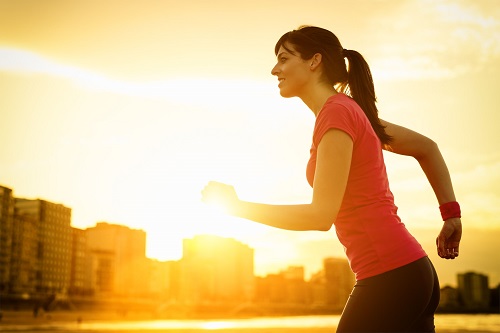
Exercising in hot weather can be stressful on your body. But there is also some research to suggest that working out in the heat and humidity can improve performance for athletes.
Whether you’re playing a game of pickup basketball or going for a jog, it’s important to take precautions to avoid heat-related illnesses like heat cramps and heat exhaustion as well as heatstroke, a life-threatening medical emergency.
Before you head outside for your next workout, take a few minutes to review these tips to help ensure your safety while exercising outdoors.
Pay attention to the time of day. Avoid exercising outside during the hottest hours of the day, generally between 10AM and 3PM. If possible, plan your workouts for the morning, before temperatures begin to climb, or in the evening after the sun begins to set.
Check the forecast. If there is a heat advisory or air quality warning for the day, consider moving your workout indoors.
Wear light-colored, loose-fitting clothing. Lighter colors help reflect heat from the sun, while dark colors absorb heat. Loose-fitting cotton material will help sweat evaporate more quickly. Wear a light-colored, wide-brimmed hat to protect your head and face if possible.
Don’t forget sunscreen. Protect your skin from sunburn and damage that can lead to skin cancer.
Stay hydrated. The warmer it is outside, the more sweat your body will produce to keep you cool. Sweat is water leaving the body, and it must be replenished to avoid dehydration. Drink at least 16 ounces of water before you go out, and consume six to eight ounces of fluids for every 15 to 20 minutes of exercise. When you’re done with your workout, drink another glass or two of water.
Replenish electrolytes. Sports drinks contain electrolytes (sodium, chloride and potassium) that are lost through sweating. These drinks aren’t necessary if you’re doing moderate exercise for less than 60 minutes, but if your workout is intense and lasts longer than an hour, replenish lost electrolytes with a sports drink after your workout.
Stick to the shade. Whenever possible, take your workout to a shaded park or trail to keep out of the sun.
Know your fitness level. If you are out of shape or are new to working out, your body may not tolerate heat as well as a well-trained athlete. Lower the intensity of your workout and take frequent breaks.
Listen to your body. If you begin feeling dizzy, faint or nauseous, stop working out immediately, get indoors and drink some water. If your symptoms do not improve quickly, seek medical attention. Other warning signs to watch for include: muscle cramps, weakness, fatigue, profuse sweating, confusion, low blood pressure, increased heart rate and vision problems.
Understand your medical risks. Some medical conditions and certain medications may make exercising in the heat more dangerous for you. Talk to your doctor about your workout plans and any other precautions you should take.
Pushing your body to the limit in the heat of the summer isn’t necessary to stay fit, but if you’re training for a summertime sporting event, acclimating your body to the heat and humidity by training outside is the best way to condition yourself for the event. Even then, don’t go overboard and know when to stop. Heat exhaustion starts with dehydration and can quickly lead to dangerous and even deadly heat stroke.
Taking these simple precautions can help you avoid the risks of dangerous heat-related illnesses.





